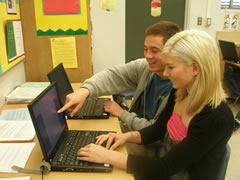
Superintendents and educational technology directors discussed how to ensure that technology is integrated into the curriculum during a Dec. 7 webinar sponsored by the Consortium for School Networking.
The webinar, entitled “Bridging the Chasm Between Curriculum & Technology,” featured a panel of four superintendents and educational technology directors from across the country who shed light on what adding more technology in the classroom has done for their students.
“We use technology as a tool to enhance student learning and really enhance students’ engagement in the content,” said Suzanne Freeman, superintendent of Trussville City Schools in Trussville, Ala. “We know that technology really entices children.”
Freeman encouraged other districts to hire a technology integration specialist to optimize the use of technology in the classroom and help tailor it to the teachers’ individual needs. She also said that districts should use a wide variety of technologies, such as Facebook, Twitter, blogs, and wikis, and that superintendents should be able to model these for their staff.
“What we are really seeing right now is a true paradigm shift,” said Sean McDonough, director of information technology for the Harrisburg City School District in Pennsylvania. “In some ways, we have a whole new way of thinking about how we’re truly using technology in today’s world because of the omnipresence that technology gives us.”
McDonough said superintendents and other district leaders need to make sure that educational technology directors are included in the curriculum planning process.
“Curriculum leaders need to know more about the technological systems that [can help lead to] effective instruction,” McDonough said.
Brian Nichols, executive director of elementary school leadership in Newport News, Va., encouraged schools to push out of their comfort zone.
“We’re not afraid to fail, we’re not afraid to take risks, but we want to do it on a smaller scale,” said Nichols. He testified that pilot programs that can be developed and then scaled up are extremely effective for schools looking to add to their use of technology in the classroom.
The panel admitted that finding low-cost ways to incorporate technology in the classroom with the economic downturn is difficult, but not impossible.
“We have really relied on free internet resources, and there are really a lot of them out there,” said Freeman. She pointed out Skype and free virtual libraries as some examples.
“The state of Virginia is definitely feeling the economy as well,” said Nichols. “As far as technology goes, there are a lot of free resources out there. There’s a lot of Web 2.0 tools. We’re always looking for resources that are out there that are high-yield [and] low-cost.”
The CoSN discussion also touched on how to reach out to faculty who aren’t as technologically savvy.
“We’ve had that over the last few years, and we have tried professional learning so they know how to use the technology,” said Freeman. She also said her district sets goals and checkpoints for everyone to reach within certain time periods.
Nichols said his district utilizes “lead learners” who are comfortable with a piece of educational technology to assist those who are not.
“That way, you’re all kind of learning this together, and you all get to that level of comfort,” said Nichols.
He added: “There really isn’t a division in our school arena now that hasn’t been impacted by technology.”
All panelists participated remotely in the discussion.
- New film fights negative perception of teachers - September 16, 2011
- Textbook-free schools share experiences, insights - September 7, 2011
- Social websites are latest sources for plagiarized material - September 1, 2011


Comments are closed.